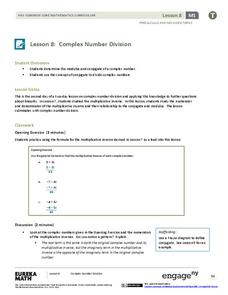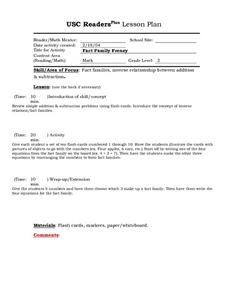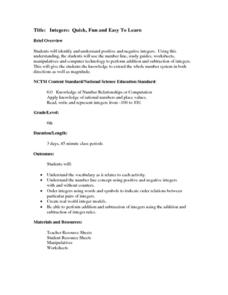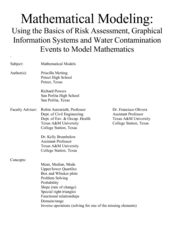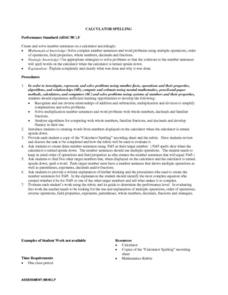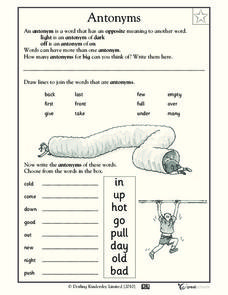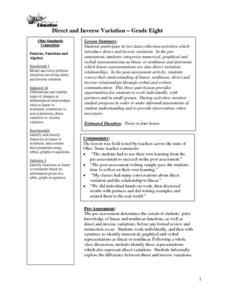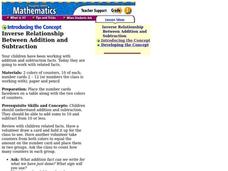Curated OER
Inverse Relationships (E)
In this inverse addition and subtraction worksheet, students examine 30 pairs of addition and subtractions sentences. Students use their problem solving skills to fill in the blanks boxes with the appropriate numbers.
Curated OER
Integrating Physics-Observing and Experimenting to Find Relationships
In this experimental relationship instructional activity, students read about direct and indirect relationships between variables in experiments. They answer three questions about relationships between variables.
EngageNY
Complex Number Division 2
Individuals learn to divide and conquer complex numbers with a little help from moduli and conjugates. In the second lesson on complex number division, the class takes a closer look at the numerator and denominator of the multiplicative...
Mathematics Vision Project
More Functions, More Features
Learners tackle a wide range of intimidating topics in this comprehensive unit that spans piecewise functions, absolute value of functions, and inverse functions (among other topics). Investigative group work alternates with more...
Curated OER
Introduction to Inverse Functions
Students investigate patterns of inverse functions. In this algebra lesson plan, students represent functions with the calculator and on paper. They analyze their data and draw conclusions.
Curated OER
Angle Relationships
In this angle relationships worksheet, 10th graders solve 7 problems related to the different types of angles that occur in pairs. First, they identify each pair of angles as adjacent, vertical, complementary, supplementary, and/or as a...
Curated OER
Inverse Relationships (5)
In this addition and subtraction fact family worksheet, students use the numbers given to fill in the missing numbers in each pair of fact families. Students solve 60 problems.
Curated OER
Inverse (Indirect) Machines
High schoolers observe relationships between quantities. Students complete activities for three different classes of levers. In groups, high schoolers build each type of lever. Students identify levers in their daily surroundings. High...
Curated OER
Proportions
In this proportions activity, students solve and complete 7 various types of problems. First, they determine the better buy based on the information provided for each word problem. Then, students find the value of a variable given its...
Curated OER
WINDMILL POWER
Learners study operations with real numbers using mental computation or paper-and-pencil calculations. They judge the reasonableness of numerical computations and their results. They set up and solve proportions for direct and inverse...
Curated OER
Fact Family Frenzy
Second graders explore fact families and inverse relationships between addition and subtraction. They use flashcards to model the inverse relationships. Students complete the equations for each fact family.
Virginia Department of Education
Types of Variations
Scholars determine how two quantities vary with respect to each other. They complete a fill-in-the-blank activity by stating whether the entities vary directly, inversely, or jointly, create equations that match different variations, and...
National Security Agency
Integers: Quick, Fun and Easy To Learn
A good complement to any integers unit contains a three-day lesson plan about positive and negative integers, adding and subtracting integers, and how to find the additive inverse. Additionally, it provides all necessary worksheets and...
Curated OER
Mathematical Modeling
Study various types of mathematical models in this math lesson plan. Learners calculate the slope to determine the risk in a situation described. They respond to a number of questions and analyze their statistical data. Then, they...
Curated OER
Matrix Madness!!
Perform operations to add, subtract, multiply and divide matrices. Then solve problems with vectors using matrices. A three day activity: Matrix Madness, Mystical Matrices, and Decode the Encode. The last activity has prizes that the...
Mathematics Vision Project
Similarity and Right Triangle Trigonometry
Starting with similar triangles and dilation factors, this unit quickly and thoroughly progresses into the world of right triangle features and trigonometric relationships. Presented in easy-to-attack modules with copious application...
Curated OER
Multiplication: Bugs Can Multiply, So Can I!
Develop multiplication skills with your class. Youngsters will visualize multiplication as repeated addition. Then they will create a multiplication bug book and discover arrays as a strategy for multiplication problem solving....
Curated OER
Spin Your Number Wheels!
Students measure and problem solve to fabricate a multi-step, interactive math-learning tool. They calculate correct number bonds (equations) while using their number wheels. Students comprehend that addition and subtraction are inverse...
Curated OER
Calculator Spelling
Sixth graders practice creating and solving number sentences on a calculator. They interact with number facts, their properties, algorithms and estimation. Each student recognizes inverse relationships of addition, subtraction,...
Curated OER
Antonym Snowmen
Pupils demonstrate their understanding of antonyms. They create snowmen and write antonyms on them. Then present their snowmen and antonyms to the class. This is a seasonal theme instructional activity.
Curated OER
Antonyms
Familiarize linguists with antonyms as they examine examples and match up opposites. First, scholars read a short description of antonyms, writing as many antonyms for big as they can. Then, they match up pairs of words that are antonyms...
Curated OER
Direct and Inverse Variation
Eighth graders participate in two data collection activities that involve direct and inverse variation. In the pre-assessment, 8th graders categorize numerical, graphical, and verbal representations as linear or nonlinear and determine...
Curated OER
Inverse Relationship Between Addition and subtraction
First graders review number facts to illustrate the relationship between addition and subtraction. In this inverse relationship instructional activity, 1st graders write an addition sentence and then invert the numbers to show the...
Pennsylvania Department of Education
Fractional Parts Using an Area Model
Learners explore multiplying fractions and their relationship to parts of a whole. They draw and shade fractional parts to show parts of a whole and fractional parts of a fraction. Pupils also use an Internet site for interactive practice.




